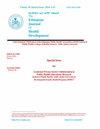Service availability and readiness for diabetes care at health facilities in Ethiopia
IF 0.5
4区 医学
Q4 PUBLIC, ENVIRONMENTAL & OCCUPATIONAL HEALTH
引用次数: 4
Abstract
Abstract Background: Non-communicable diseases (NCDs) are the leading causes of death globally. Available data demonstrate that nearly 80% deaths of NCDs occur in low- and middle-income countries. Of these deaths, an estimated 1.5 million, or 4% were due to diabetes. In Ethiopia, data on the preparedness of health facilities to cope with the rising epidemic of diabetes are insufficient. Objective: This survey was aimed to assess service availability and readiness for diabetes health care. Methods: The data used in this study is part of the 2014 Ethiopian service provision assessment survey which was conducted from 10 March to 25 July, 2014. The study employed stratified random sampling designed to provide representative results for Ethiopia. In this study, health facility types managed by different management authorities were included from the eleven administrative regions of the country. There were a total of 873 health facilities included in this particular study. Data were collected using a facility inventory questionnaire that assessed whether the providers in the facility are prepared to provide required services to patients with diabetes. Information about readiness of facilities to provide good-quality client services on diabetes, including the availability of guidelines, trained staff, basic medical equipment, and essential medicines were also collected. Results: Among all health facilities, 59% of health facilities offer services for diabetes. Forty percent of the facilities have diagnostic capacity for blood glucose while 56 % have capacity for urine protein test and 52 % has urine glucose test. Of the facilities that offer service for diabetes, 12 % of them had guidelines for diagnosis and management of diabetes at the service site during the survey. On the other hand, facilities that offer diabetes services were more likely to have basic equipment that support and enhance the provision of services. Conclusions: The findings indicate that availability of treatment services, guidelines for diagnosis and management, trained staff and medicines for diabetes were found to be inadequate. But the availability of the basic medical equipment necessary for the diagnosis and management of diabetes appear to be adequate. Therefore, strengthening health care system towards improved service delivery through availing national guidelines, protocols or standards for managing diabetes, in-service training for providers, and provision of essential ¬medicines are required to improve diabetes service delivery in health facilities. [Ethiop. J. Health Dev. 2017;31(2):110-118] Key words: Diabetes Mellitus, Disease, Service, Availability, Readiness, Health Facility, Ethiopia埃塞俄比亚卫生机构糖尿病护理服务的提供情况和准备情况
背景:非传染性疾病(NCDs)是全球死亡的主要原因。现有数据表明,近80%的非传染性疾病死亡发生在低收入和中等收入国家。在这些死亡中,估计有150万人(或4%)死于糖尿病。在埃塞俄比亚,关于卫生设施为应对日益流行的糖尿病做好准备的数据不足。目的:本调查旨在评估糖尿病保健服务的可用性和准备情况。方法:本研究使用的数据是2014年埃塞俄比亚服务提供评估调查的一部分,该调查于2014年3月10日至7月25日进行。本研究采用分层随机抽样,旨在为埃塞俄比亚提供具有代表性的结果。在这项研究中,包括了来自该国11个行政区域的不同管理当局管理的卫生设施类型。在这项特别的研究中,总共有873个卫生设施。使用设施清单问卷收集数据,评估设施中的提供者是否准备为糖尿病患者提供所需的服务。还收集了有关设施是否准备好为糖尿病患者提供高质量服务的信息,包括提供指南、训练有素的工作人员、基本医疗设备和基本药物的情况。结果:在所有卫生机构中,59%的卫生机构提供糖尿病服务。40%的设施具有血糖诊断能力,56%的设施具有尿蛋白检测能力,52%的设施具有尿糖检测能力。在提供糖尿病服务的机构中,12%的机构在调查期间在服务点制定了糖尿病诊断和管理指南。另一方面,提供糖尿病服务的机构更有可能拥有支持和加强服务提供的基本设备。结论:调查结果表明,糖尿病治疗服务、诊断和管理指南、训练有素的工作人员和药物的可得性不足。但是,诊断和治疗糖尿病所需的基本医疗设备似乎是充足的。因此,需要通过利用国家糖尿病管理指南、协议或标准、对提供者进行在职培训和提供基本药物来加强卫生保健系统,以改善服务提供,从而改善卫生设施中的糖尿病服务提供。[阿比西尼亚人。[j] .卫生发展,2017,31(2):110-118 .]关键词:糖尿病,疾病,服务,可得性,准备,卫生设施,埃塞俄比亚
本文章由计算机程序翻译,如有差异,请以英文原文为准。
求助全文
约1分钟内获得全文
求助全文
来源期刊

Ethiopian Journal of Health Development
PUBLIC, ENVIRONMENTAL & OCCUPATIONAL HEALTH-
CiteScore
0.80
自引率
0.00%
发文量
0
审稿时长
>12 weeks
期刊介绍:
The Ethiopian Journal of Health Development is a multi and interdisciplinary platform that provides space for public health experts in academics, policy and programs to share empirical evidence to contribute to health development agenda.
We publish original research articles, reviews, brief communications and commentaries on public health issues, to inform current research, policy and practice in all areas of common interest to the scholars in the field of public health, social sciences and humanities, health practitioners and policy makers. The journal publishes material relevant to any aspect of public health from a wide range of fields: epidemiology, environmental health, health economics, reproductive health, behavioral sciences, nutrition, psychiatry, social pharmacy, medical anthropology, medical sociology, clinical psychology and wide arrays of social sciences and humanities.
The journal publishes the following types of contribution:
1) Peer-reviewed original research articles and critical or analytical reviews in any area of social public health. These papers may be up to 3,500 words excluding abstract, tables, and references. Papers below this limit are preferred.
2) Peer-reviewed short reports of research findings on topical issues or published articles of between 2000 and 4000 words.
3) Brief communications, and commentaries debating on particular areas of focus, and published alongside, selected articles.
4) Special Issues bringing together collections of papers on a particular theme, and usually guest edited.
5) Editorial that flags critical issues of public health debate for policy, program and scientific consumption or further debate
 求助内容:
求助内容: 应助结果提醒方式:
应助结果提醒方式:


